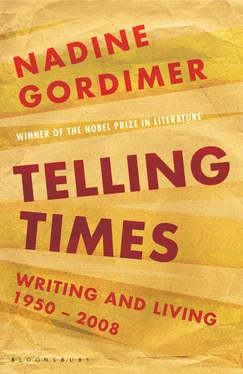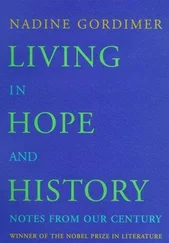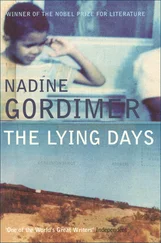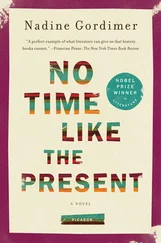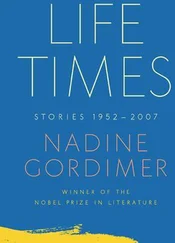We, of course, were town people. All my childhood, we lived in the little house, in one of the town’s earliest suburbs, that my parents had bought before I was born. Other people moved to the newer suburbs of flat-roofed villas, pseudo-Tudor houses, and, later, houses inspired by American magazines, with picture windows looking out on the bare veld. But we stayed. Ours was a bungalow-type house with two bow windows and a corrugated-iron roof, like almost all the other houses that were built in the Witwatersrand gold-mining towns during the twenties and early thirties. It stood in a small garden, one of several similar houses on a street along whose sidewalk grew leathery-leaved trees, which in summer put out bunches of creamy, bell-shaped flowers. When my sister and I were little, we used to fit these flowers over our fingertips, like tiny hats; when we were old enough to own bicycles, we would ride up and down beneath the trees, feeling rather than hearing the swish of their leaves above our heads. The trees were kept clipped in the shape of bullets, in order that they might not interfere with the telephone wires, and so were not beautiful. There was, in fact, no beauty in the whole town. We children simply took it for granted that beauty — hills, trees, buildings of elegance — was not a thing to be expected of ordinary, everyday life.
The town had already grown up and hardened, as it were, into permanent shape before its leaders became sophisticated enough to consider orthodox municipal planning, and so, although it kept expanding in all directions, it remained essentially a one-street affair. As is so often true in such cases, that street was too narrow, and the land on either side of it was too valuable to make widening feasible. The street had the authentic jostle and bustle of a thriving business centre, and we children loved to walk ‘downtown’ on Saturday mornings with our mother. This was as much a social as a shopping expedition. During our early years, the only places of refreshment in the town were two or three hotel bars (in South Africa, closed to women anyway) and the Greek cafés, where black-haired Minos or Mavrodatos sold cigarettes, sweets, polony and fruit, and where one could sit at a table with a flyblown cloth and be served terribly weak tea or coffee adulterated with chicory. But by the middle thirties there were one or two genteel teashops, where the local women met for mid-morning refreshment, and the Greeks had installed shiny soda fountains, which we children used to patronise heavily after Saturday matinées at the local cinema.
Most of the shops were family businesses, but with prosperity came Woolworth’s — from whose gramophone-record counter dated jazz swung out into the main street — and branches of various big department stores in Johannesburg. The owners of the family businesses became the city fathers, and their families became the ‘old families’ of the town. We were one of these ‘old families’ and were known to everyone in the town and even at the mines — there by sight rather than by association. My father took no part in civic affairs and remained what he had always been, a simple man and a shopkeeper, but my mother, a woman of considerable energy and not much scope, served on endless committees. Some years, she was president of several organisations at once, with a secretaryship or two thrown in as well. She baked cakes and she prepared reports; she was honorary cashier at charity concerts, and she taught first aid to children. Her position was a curious one. Unlike most of the other women, she did not confine herself to the particular section of the community to which she belonged. The fact was that she didn’t seem to belong to any particular section. Although my father kept up some sort of token allegiance to the Jewish community, contributing to the upkeep of the ugly little synagogue and even going to pray there once a year, on the Day of Atonement, my mother did not fit in very well with the ladies of the congregation. She got on much better with the Scots ladies of the town, and I remember her working (or, rather, baking) like a beaver for the annual cake-and-sweet sale in aid of the Presbyterian Church.
Our life was very much our mother’s life, and so our pleasures, into which we plunged with gusto, knowing no others, were charity bazaars, the local eisteddfods that were held in the town hall by members of the Welsh community, and dancing displays by the pupils of local teachers (my sister and I were often performers), along with — staple stimulation for the entire population — the cinema. In summer, we went to the municipal swimming baths. Walks or rambles about the outskirts of the town were unknown to us, except for those furtive excursions in the direction of the burning dump. There was nothing to see beyond the limits of the suburbs but ‘the location’ — an urban slum where the African industrial workers and servants were huddled in segregation from their white employers — and a dammed-up pond, created by waste water pumped from one of the mines, in which a yellow cyanide dump was reflected, its image broken by bulrushes and the occasional passage of a small wild duck.
There were junior and senior state schools in the town, where education for white children was free, but my sister and I were sent as day scholars to the local convent; the Dominican nuns had come, like everything else, with the town’s prosperity. Many of the townspeople, torn between the businessman’s natural suspicion of getting something for nothing and the fear that their children would be converted to Catholicism (the town was largely Protestant), resolved the issue by sending their children to neither the state school nor the convent but to boarding school in Johannesburg. My mother, a fearless nomad when it came to social and religious barriers, had no such misgivings. My sister and I spent our school life at the convent, and were taught English by a bun-faced nun with a thick German accent. At school, I showed some of my mother’s bland disregard for the sheeplike group consciousness of the town, and struck up a long and close friendship with the daughter of an official at one of the oldest and most important mines. So it was that I came to cross the tacit divide between the mines and the town, and to know the habitat, domestic life and protocol of ‘the mine people’.
Like middle-class children everywhere who live within reasonable reach of an ocean, we were taken to the sea every year. The hot months of December and January are the popular season for family holidays in South Africa, the Indian Ocean is the nearest ocean for Transvaalers, and Durban — 400 miles from Johannesburg — is the nearest city on the Indian Ocean coast. So almost every summer we spent our three weeks in Durban or in a village on the South Coast, not far from Durban. We could, of course, have gone to Lourenço Marques, the gay little port in Portuguese territory, which is about the same distance from Johannesburg, but we never did, because that was a place to which grown-ups went without their children (and preferably without their wives or husbands) and only in the winter season of July and August. When we were very small, we adored Durban, where we stayed in one of the solid, cool, high-ceilinged hotels along the Marine Parade and, leaning out of the steamy bathroom in the evening, after we had been sent off to bed, could see the coloured lights strung like beads on an abacus from lamp post to lamp post along the sea front while the trams thundered past, and a strange fading and rising cry — a mingling of laughter, squeals, and juke-box and hurdy-gurdy music — rose, between the roaring advance and hissing retreat of the sea, from the amusement park.
When we grew a little older and entered that dreamy, remote, soulful state that comes sometimes in early adolescence, we found the crowded beach, the sand lumpy with popcorn, and the vulgarly lit sea front, where all the wires and cables of an electrically contrived fairyland showed on the lamp posts in the light of day, utterly abhorrent. Nothing would have persuaded us to enter the amusement park, from which wonderful teddy bears and even a felt Mickey Mouse had once come, won by our mother by dint of Heaven knows how many tickets at the sideshows, and placed at the foot of our beds for discovery in the morning. Nothing would have bored us more than the slow, chugging trips around the bay on a pleasure launch named the Sarie Marais , which only a few years back had had all the solemn thrill of departure for a new continent. And most of all we revolted against the nagging of the Indian vendors on the beach, with their ‘Mangoes? Litchis? Banana? Very nice p-ruit? Grandailla parfait? Ice cream?’ Gesture one angrily away, and another, sweating, scowling, barefooted on the burning sand but dressed from head to foot in white drill embroidered with some unlikely name — Joe’s Place, or the Top Hat — came at you like a persistent blue-bottle. You must want something . ‘No, no, no, no!’ my sister would shout in rage, and the vendor would stare at her, waiting for her to change her mind.
Читать дальше
